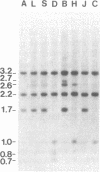Abstract
The gene encoding the neural cell adhesion molecule, N-CAM, has been localized on mouse chromosome 9. A BALB/cJ mouse genomic library prepared in lambda bacteriophage EMBL4 was screened by using a cDNA probe, pEC204, that corresponds to the coding region of the chicken N-CAM gene. Four weakly reactive and one strongly reactive recombinant phage were isolated. A region of the latter that was strongly homologous to pEC204 was subcloned to yield a new probe, pEC501. RNA transfer blots and nucleotide sequencing indicated that pEC501 encoded part of the mouse N-CAM gene. This probe defined a unique genetic locus, Ncam, associated with a restriction fragment length polymorphism that allowed the definition of two alleles. The locus could be provisionally assigned either to chromosome 9 or to chromosome 10 by correlating the presence or absence of mouse-specific DNA fragments reactive with the probe in a panel of somatic hybrid cell lines with the presence or absence of the various mouse chromosomes. Analysis of the inheritance of the Ncam-associated DNA polymorphism in recombinant inbred strains of mice revealed close linkage between Ncam and the Lap-1, Sep-1, and Thy-1 loci on chromosome 9. This result suggests an additional linkage between Ncam and the locus for the cerebellar mutation staggerer (sg). The Ncam locus provides an important reference point for mapping the genes for additional cell adhesion molecules as well as genes for other molecules involved in neural development and function.
Full text
PDF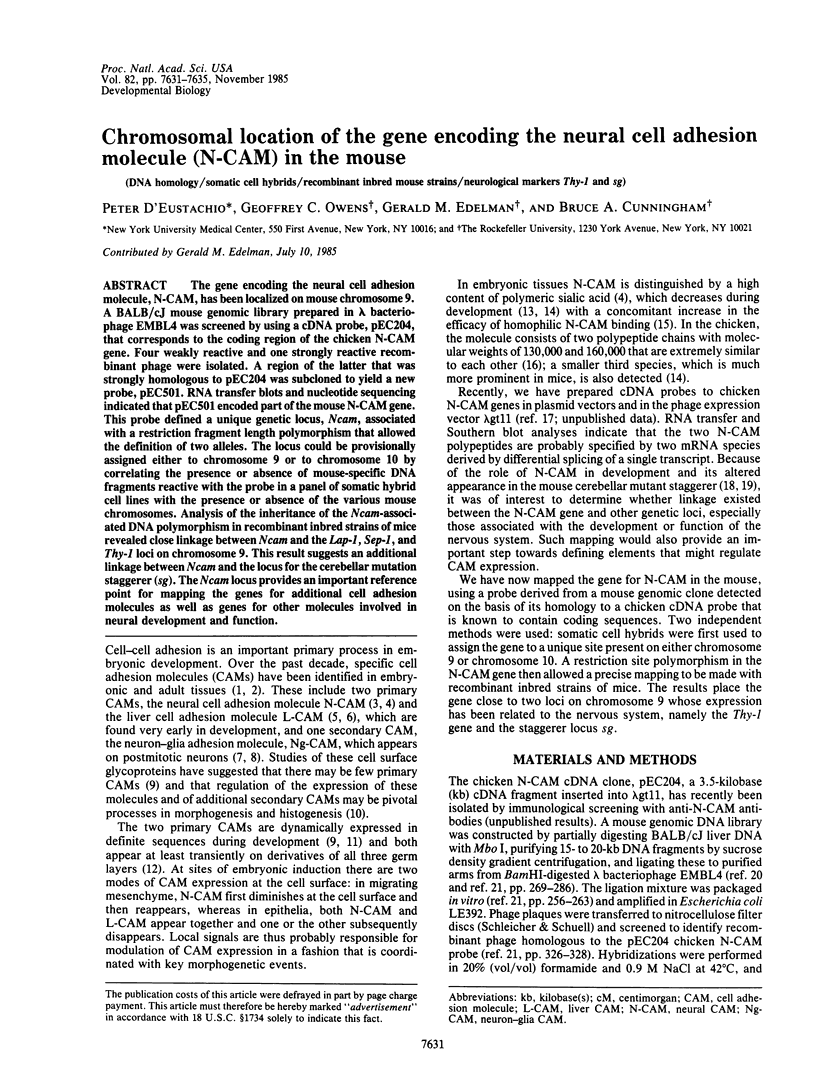
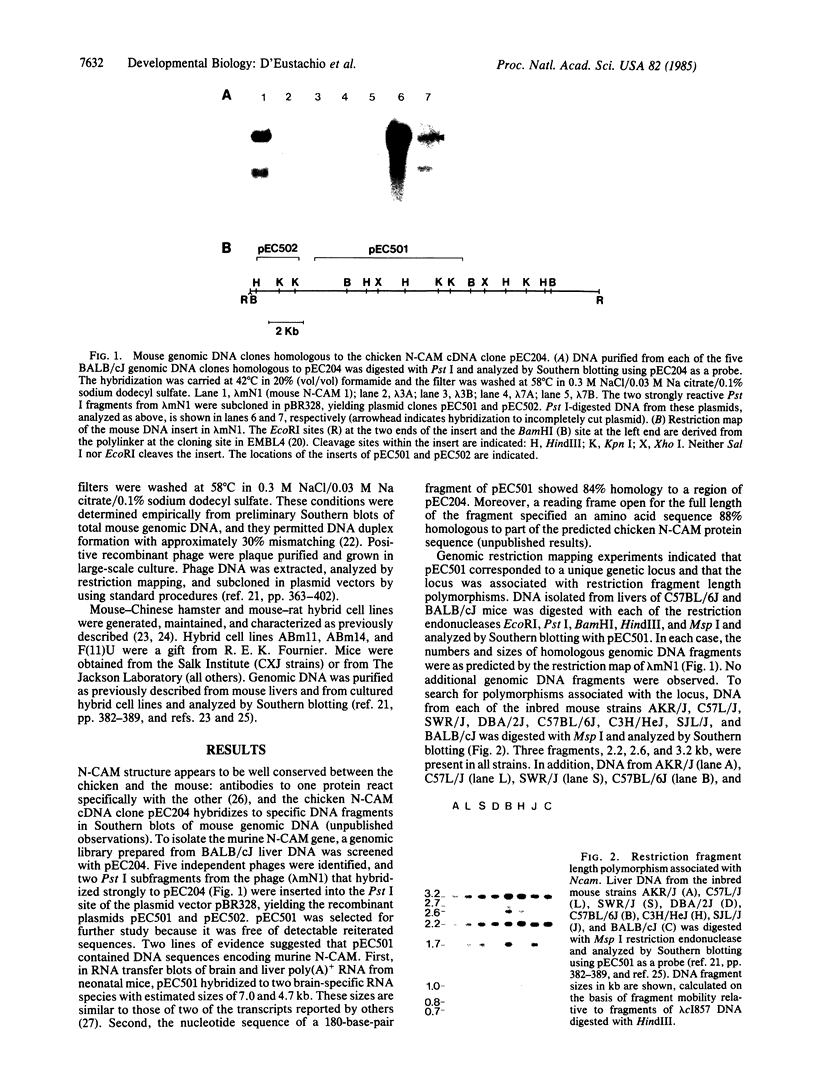
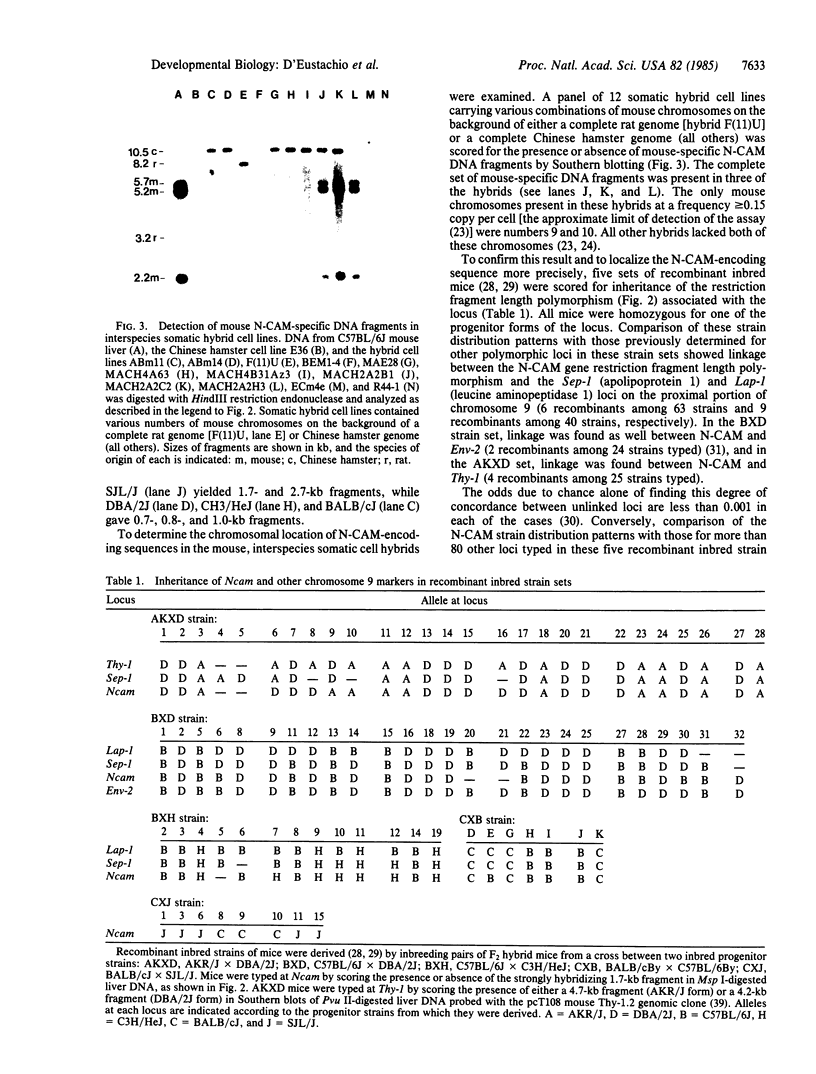
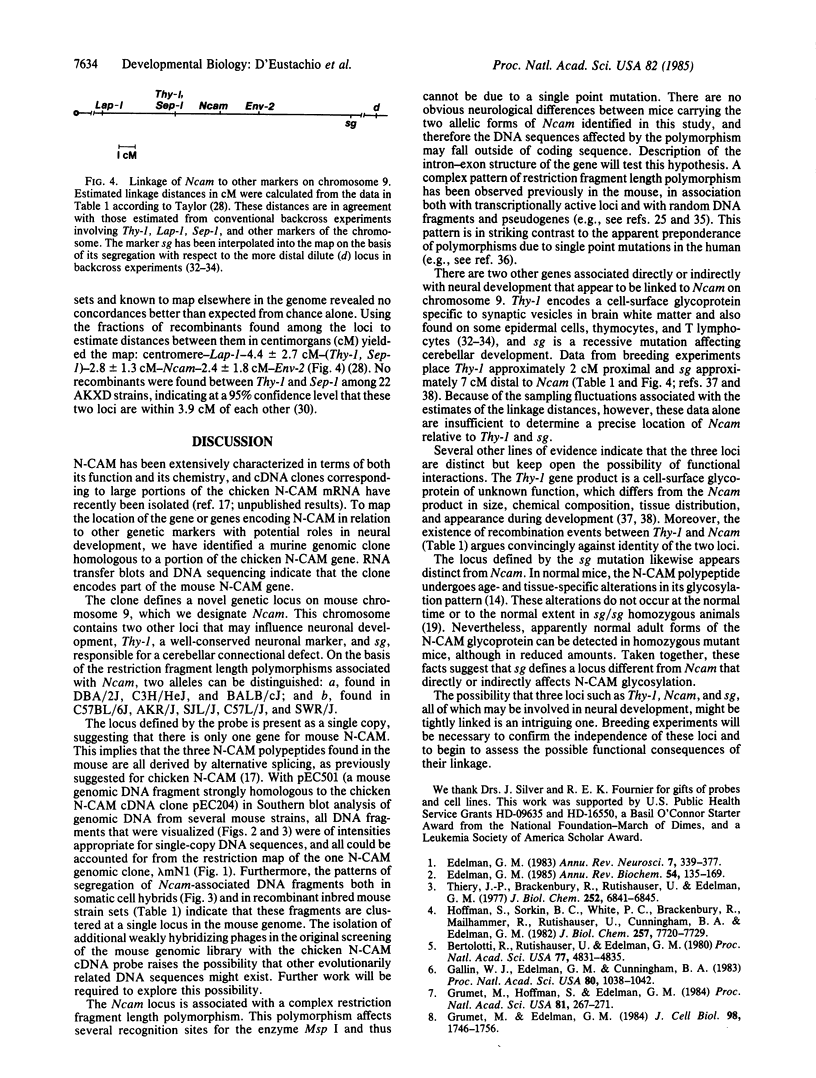
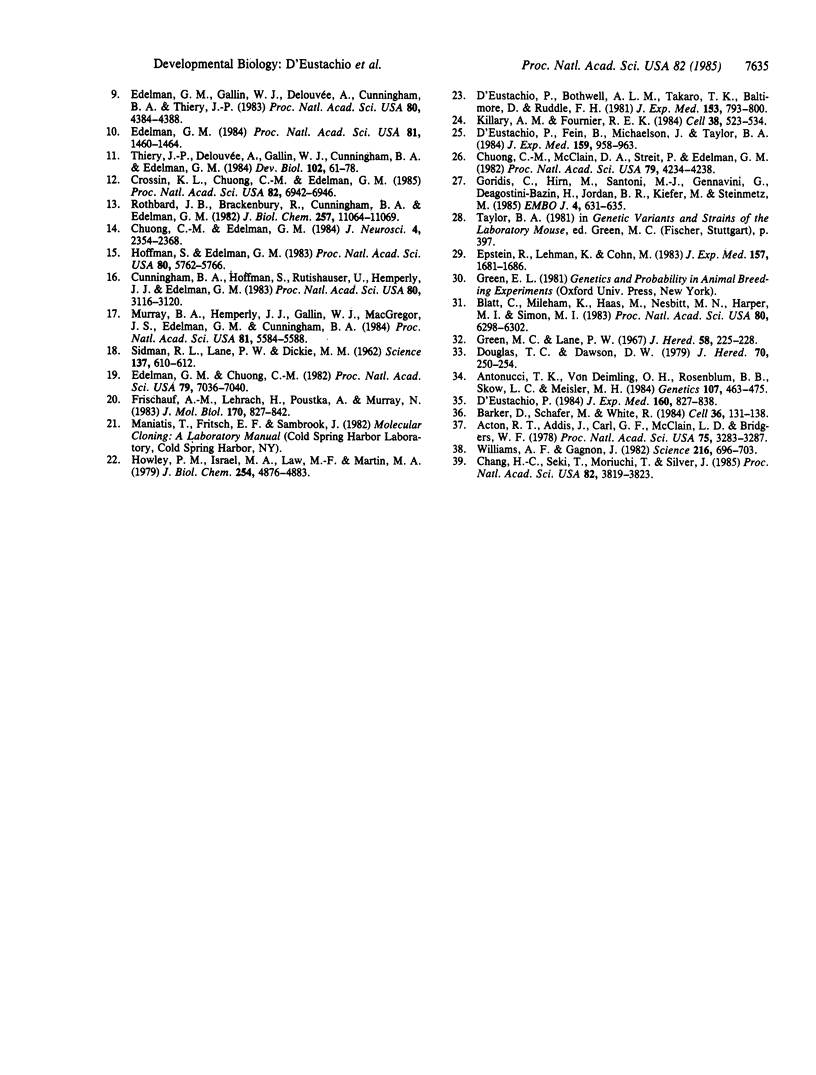
Images in this article
Selected References
These references are in PubMed. This may not be the complete list of references from this article.
- Acton R. T., Addis J., Carl G. F., McClain L. D., Bridgers W. F. Association of Thy-1 differentiation alloantigen with synaptic complexes isolated from mouse brain. Proc Natl Acad Sci U S A. 1978 Jul;75(7):3283–3287. doi: 10.1073/pnas.75.7.3283. [DOI] [PMC free article] [PubMed] [Google Scholar]
- Antonucci T. K., Von Deimling O. H., Rosenblum B. B., Skow L. C., Meisler M. H. Conserved linkage within a 4-cM region of mouse chromosome 9 and human chromosome 11. Genetics. 1984 Jul;107(3):463–475. doi: 10.1093/genetics/107.3.463. [DOI] [PMC free article] [PubMed] [Google Scholar]
- Barker D., Schafer M., White R. Restriction sites containing CpG show a higher frequency of polymorphism in human DNA. Cell. 1984 Jan;36(1):131–138. doi: 10.1016/0092-8674(84)90081-3. [DOI] [PubMed] [Google Scholar]
- Bertolotti R., Rutishauser U., Edelman G. M. A cell surface molecule involved in aggregation of embryonic liver cells. Proc Natl Acad Sci U S A. 1980 Aug;77(8):4831–4835. doi: 10.1073/pnas.77.8.4831. [DOI] [PMC free article] [PubMed] [Google Scholar]
- Blatt C., Mileham K., Haas M., Nesbitt M. N., Harper M. E., Simon M. I. Chromosomal mapping of the mink cell focus-inducing and xenotropic env gene family in the mouse. Proc Natl Acad Sci U S A. 1983 Oct;80(20):6298–6302. doi: 10.1073/pnas.80.20.6298. [DOI] [PMC free article] [PubMed] [Google Scholar]
- Chang H. C., Seki T., Moriuchi T., Silver J. Isolation and characterization of mouse Thy-1 genomic clones. Proc Natl Acad Sci U S A. 1985 Jun;82(11):3819–3823. doi: 10.1073/pnas.82.11.3819. [DOI] [PMC free article] [PubMed] [Google Scholar]
- Chuong C. M., Edelman G. M. Alterations in neural cell adhesion molecules during development of different regions of the nervous system. J Neurosci. 1984 Sep;4(9):2354–2368. doi: 10.1523/JNEUROSCI.04-09-02354.1984. [DOI] [PMC free article] [PubMed] [Google Scholar]
- Chuong C. M., McClain D. A., Streit P., Edelman G. M. Neural cell adhesion molecules in rodent brains isolated by monoclonal antibodies with cross-species reactivity. Proc Natl Acad Sci U S A. 1982 Jul;79(13):4234–4238. doi: 10.1073/pnas.79.13.4234. [DOI] [PMC free article] [PubMed] [Google Scholar]
- Crossin K. L., Chuong C. M., Edelman G. M. Expression sequences of cell adhesion molecules. Proc Natl Acad Sci U S A. 1985 Oct;82(20):6942–6946. doi: 10.1073/pnas.82.20.6942. [DOI] [PMC free article] [PubMed] [Google Scholar]
- Cunningham B. A., Hoffman S., Rutishauser U., Hemperly J. J., Edelman G. M. Molecular topography of the neural cell adhesion molecule N-CAM: surface orientation and location of sialic acid-rich and binding regions. Proc Natl Acad Sci U S A. 1983 May;80(10):3116–3120. doi: 10.1073/pnas.80.10.3116. [DOI] [PMC free article] [PubMed] [Google Scholar]
- D'Eustachio P. A genetic map of mouse chromosome 12 composed of polymorphic DNA fragments. J Exp Med. 1984 Sep 1;160(3):827–838. doi: 10.1084/jem.160.3.827. [DOI] [PMC free article] [PubMed] [Google Scholar]
- D'Eustachio P., Bothwell A. L., Takaro T. K., Baltimore D., Ruddle F. H. Chromosomal location of structural genes encoding murine immunoglobulin lambda light chains. Genetics of murine lambda light chains. J Exp Med. 1981 Apr 1;153(4):793–800. doi: 10.1084/jem.153.4.793. [DOI] [PMC free article] [PubMed] [Google Scholar]
- D'Eustachio P., Fein B., Michaelson J., Taylor B. A. The alpha-globin pseudogene on mouse chromosome 17 is closely linked to H-2. J Exp Med. 1984 Mar 1;159(3):958–963. doi: 10.1084/jem.159.3.958. [DOI] [PMC free article] [PubMed] [Google Scholar]
- Douglas T. C., Dawson P. E. Location of the gene for theta antigen in the mouse. III. The position of Thy-1 relative to Lap-1 and Mpi-1. J Hered. 1979 Jul-Aug;70(4):250–254. doi: 10.1093/oxfordjournals.jhered.a109248. [DOI] [PubMed] [Google Scholar]
- Edelman G. M. Cell adhesion and morphogenesis: the regulator hypothesis. Proc Natl Acad Sci U S A. 1984 Mar;81(5):1460–1464. doi: 10.1073/pnas.81.5.1460. [DOI] [PMC free article] [PubMed] [Google Scholar]
- Edelman G. M. Cell adhesion and the molecular processes of morphogenesis. Annu Rev Biochem. 1985;54:135–169. doi: 10.1146/annurev.bi.54.070185.001031. [DOI] [PubMed] [Google Scholar]
- Edelman G. M., Chuong C. M. Embryonic to adult conversion of neural cell adhesion molecules in normal and staggerer mice. Proc Natl Acad Sci U S A. 1982 Nov;79(22):7036–7040. doi: 10.1073/pnas.79.22.7036. [DOI] [PMC free article] [PubMed] [Google Scholar]
- Edelman G. M., Gallin W. J., Delouvée A., Cunningham B. A., Thiery J. P. Early epochal maps of two different cell adhesion molecules. Proc Natl Acad Sci U S A. 1983 Jul;80(14):4384–4388. doi: 10.1073/pnas.80.14.4384. [DOI] [PMC free article] [PubMed] [Google Scholar]
- Edelman G. M. Modulation of cell adhesion during induction, histogenesis, and perinatal development of the nervous system. Annu Rev Neurosci. 1984;7:339–377. doi: 10.1146/annurev.ne.07.030184.002011. [DOI] [PubMed] [Google Scholar]
- Epstein R., Lehmann K., Cohn M. Induction of lambda 1-immunoglobulin is determined by a regulatory gene (r lambda 1) linked (or identical) to the structural (c lambda 1) gene. J Exp Med. 1983 May 1;157(5):1681–1686. doi: 10.1084/jem.157.5.1681. [DOI] [PMC free article] [PubMed] [Google Scholar]
- Frischauf A. M., Lehrach H., Poustka A., Murray N. Lambda replacement vectors carrying polylinker sequences. J Mol Biol. 1983 Nov 15;170(4):827–842. doi: 10.1016/s0022-2836(83)80190-9. [DOI] [PubMed] [Google Scholar]
- Gallin W. J., Edelman G. M., Cunningham B. A. Characterization of L-CAM, a major cell adhesion molecule from embryonic liver cells. Proc Natl Acad Sci U S A. 1983 Feb;80(4):1038–1042. doi: 10.1073/pnas.80.4.1038. [DOI] [PMC free article] [PubMed] [Google Scholar]
- Goridis C., Hirn M., Santoni M. J., Gennarini G., Deagostini-Bazin H., Jordan B. R., Kiefer M., Steinmetz M. Isolation of mouse N-CAM-related cDNA: detection and cloning using monoclonal antibodies. EMBO J. 1985 Mar;4(3):631–635. doi: 10.1002/j.1460-2075.1985.tb03676.x. [DOI] [PMC free article] [PubMed] [Google Scholar]
- Grumet M., Edelman G. M. Heterotypic binding between neuronal membrane vesicles and glial cells is mediated by a specific cell adhesion molecule. J Cell Biol. 1984 May;98(5):1746–1756. doi: 10.1083/jcb.98.5.1746. [DOI] [PMC free article] [PubMed] [Google Scholar]
- Grumet M., Hoffman S., Edelman G. M. Two antigenically related neuronal cell adhesion molecules of different specificities mediate neuron-neuron and neuron-glia adhesion. Proc Natl Acad Sci U S A. 1984 Jan;81(1):267–271. doi: 10.1073/pnas.81.1.267. [DOI] [PMC free article] [PubMed] [Google Scholar]
- Hoffman S., Edelman G. M. Kinetics of homophilic binding by embryonic and adult forms of the neural cell adhesion molecule. Proc Natl Acad Sci U S A. 1983 Sep;80(18):5762–5766. doi: 10.1073/pnas.80.18.5762. [DOI] [PMC free article] [PubMed] [Google Scholar]
- Hoffman S., Sorkin B. C., White P. C., Brackenbury R., Mailhammer R., Rutishauser U., Cunningham B. A., Edelman G. M. Chemical characterization of a neural cell adhesion molecule purified from embryonic brain membranes. J Biol Chem. 1982 Jul 10;257(13):7720–7729. [PubMed] [Google Scholar]
- Howley P. M., Israel M. A., Law M. F., Martin M. A. A rapid method for detecting and mapping homology between heterologous DNAs. Evaluation of polyomavirus genomes. J Biol Chem. 1979 Jun 10;254(11):4876–4883. [PubMed] [Google Scholar]
- Killary A. M., Fournier R. E. A genetic analysis of extinction: trans-dominant loci regulate expression of liver-specific traits in hepatoma hybrid cells. Cell. 1984 Sep;38(2):523–534. doi: 10.1016/0092-8674(84)90507-5. [DOI] [PubMed] [Google Scholar]
- Murray B. A., Hemperly J. J., Gallin W. J., MacGregor J. S., Edelman G. M., Cunningham B. A. Isolation of cDNA clones for the chicken neural cell adhesion molecule (N-CAM). Proc Natl Acad Sci U S A. 1984 Sep;81(17):5584–5588. doi: 10.1073/pnas.81.17.5584. [DOI] [PMC free article] [PubMed] [Google Scholar]
- Rothbard J. B., Brackenbury R., Cunningham B. A., Edelman G. M. Differences in the carbohydrate structures of neural cell-adhesion molecules from adult and embryonic chicken brains. J Biol Chem. 1982 Sep 25;257(18):11064–11069. [PubMed] [Google Scholar]
- SIDMAN R. L., LANE P. W., DICKIE M. M. Staggerer, a new mutation in the mouse affecting the cerebellum. Science. 1962 Aug 24;137(3530):610–612. doi: 10.1126/science.137.3530.610. [DOI] [PubMed] [Google Scholar]
- Thiery J. P., Brackenbury R., Rutishauser U., Edelman G. M. Adhesion among neural cells of the chick embryo. II. Purification and characterization of a cell adhesion molecule from neural retina. J Biol Chem. 1977 Oct 10;252(19):6841–6845. [PubMed] [Google Scholar]
- Thiery J. P., Delouvée A., Gallin W. J., Cunningham B. A., Edelman G. M. Ontogenetic expression of cell adhesion molecules: L-CAM is found in epithelia derived from the three primary germ layers. Dev Biol. 1984 Mar;102(1):61–78. doi: 10.1016/0012-1606(84)90175-1. [DOI] [PubMed] [Google Scholar]
- Williams A. F., Gagnon J. Neuronal cell Thy-1 glycoprotein: homology with immunoglobulin. Science. 1982 May 14;216(4547):696–703. doi: 10.1126/science.6177036. [DOI] [PubMed] [Google Scholar]




